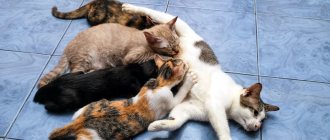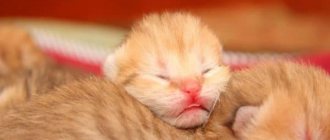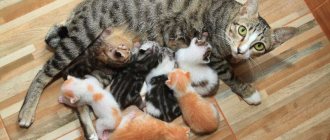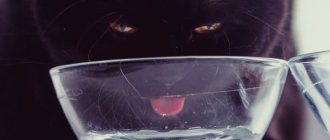If a young cat has appeared in your home, then today you need to think about how you plan to protect her from unwanted pregnancies. Many people think it’s too early to think about this, because in front of you is a playful kitten. In fact, time flies very quickly. Every owner should know at what age a cat can become pregnant, because forewarned is forearmed.
Preparing for childbirth
You need to thoroughly prepare for childbirth. To do this, you will need not only to arrange the place where the kittens will appear, but also to prepare some tools and materials that may be needed in case of complications that arise. In addition, you should make sure that you have medications on hand and be sure to write down the veterinarian’s phone number so that you can contact him at any time.
Arrangement of the “nest”
A large box is perfect for temporary housing for the mother and her offspring. To make it easier for the cat to climb into it, one side can be made lower than the rest. It is not recommended to make a slot along the entire height of the box to prevent the kittens from escaping.
Mother cat with her kittens
The bottom of the box can be covered with a rubber or foam mat, or a piece of similar material, oilcloth. This will protect the cardboard from accidental wetness. Place a cloth or disposable diaper on top.
It is advisable for the box to stand in the place chosen by the cat, but, in most cases, mustachioed mothers prefer closets or the owner’s bed. The place where the box will be placed should be quiet, warm, and secluded. You need to gradually accustom your pet to the “nest” by placing drinking water and food nearby. In the end, she will understand what is required of her and will accept the proposed option.
Preparing tools
By the time of birth, items should be prepared that may be needed if the situation takes an unexpected turn:
- scissors;
- sterile rubber gloves;
- Vaseline oil;
- antiseptic (brilliant);
- syringe;
- dishes for clean water;
- cotton buds;
- threads;
- syringes of different sizes;
- disposable diapers;
- pieces of cotton fabric (they must be pre-washed and ironed).
All accessories must be in one place and in “combat readiness”: clean and disinfected.
Medications
In some cases, your mustachioed pet may need medical assistance, so in addition to the tools, you should prepare some medications.
- Oxytocin. It will help with a sudden cessation of contractions or weak labor. Promotes contraction of the uterine walls. Used as injections into the withers area in a dosage of 0.2 ml.
- Travmatin. As soon as the woman in labor begins, you can give an injection of this drug in a dosage of 1 ml. After the end of childbirth, the drug is used for the next three days, one injection per day. Travmatin eliminates pain, prevents the development of the inflammatory process, has an antimicrobial effect, and reduces the likelihood of infectious complications.
- Calcium gluconate. In the form of an injection solution, it is used in a dosage of 1 ml for the normal course of labor and the prevention of eclampsia.
A little physiology
If a cat feeds her kittens with milk, then she has no time to look for adventures, so on average, young individuals become mothers twice a year. The older the animal becomes, the longer the recovery period and, accordingly, the cat gives birth less often. When for some reason a cat loses her cubs, the recovery period after birth is delayed or occurs with complications (for example, inflammation of the mammary glands is possible). In this case, you need to consult a doctor. Usually the veterinarian prescribes injections of hormonal drugs, recommends giving less liquid to drink, and applies a medicinal bandage to the cat.
If the kittens are taken from the mother too early, without allowing her to feed the litter, she may again begin to insistently demand mating.
Pedigree representatives of the cat family are allowed to register up to 2 litters per year. Since a period of 8 months is considered optimal for the restoration of the body, 3 litters within two years are normal.
Thus, the correct answer to the question “Until what age do cats give birth?” sounds like this: an animal is capable of producing kittens until its death. However, to avoid pathological births and defective babies, breeders prefer to castrate or sterilize their pets at the age of 6 or 7 years.
Timing and stages of pregnancy
Gestation of kittens lasts from 58 to 78 days. It depends on the size of the animal and the breed. For example, Siamese cats bear offspring faster. After about three weeks, the nipples become enlarged, and it becomes possible to feel the babies in the tummy. At this time, the cat must be provided with adequate nutrition. It is best if it is special food for pregnant and lactating women.
When there are 1-2 days left before giving birth, the expectant mother becomes restless. She clings to her owner, looks for a secluded corner, meows. Now it’s best to equip her with a nest. A cat attached to its owner will want to give birth in his bed, and a very independent lady will try to leave the house for this. A cozy nest will help you avoid these extremes.
How to understand that a cat is about to give birth
It is very easy to determine that a cat is giving birth in the near future. At this time, her behavior changes radically. This may be evidenced by the following cat behavior:
- Starts to thrash around and meow loudly;
- Constantly licks his genitals;
- Begins to toss and turn, exposing his belly to be stroked;
- Starts to breathe heavily.
If your pet begins to worry, it would be best to take her to the place prepared for childbirth, sit next to her and stroke her.
This is especially important if the cat is emotionally attached to the owner. In this case, his presence will greatly help during the birth process, calming her down.
Watching your pet grow up
This process is certainly very interesting to watch. Many owners simply cannot be torn away from their pets, because they want to remember all the changes in behavior and character. Of course, a kitten can grow up in a matter of months! Just yesterday he had trouble standing on his paws and fell awkwardly, but today he is a beautiful, graceful cat that quickly maneuvers from the refrigerator to the windowsill.
At every stage of growing up, pets need good nutrition, timely medical care and good physical activity. Only in this case will the cat be able to grow up healthy and live a long and happy life.
To ensure that your pet develops correctly and without complications, adoption staff recommend an annual examination by a veterinarian. Even if the cat looks healthy on the outside.
Read more about this: Annual visit to the veterinarian - what is included and why it is needed
What does (low) multiple pregnancy depend on?
There are both a huge number of hypotheses and scientifically proven facts on this matter. Our topic is not a dissertation for an academic degree, so we will lump all theories and evidence into one common pile.
Proper and nutritious nutrition has an important influence on conception, subsequent pregnancy and childbirth: the worse a cat eats, the less likely it is to become pregnant. There is such a thing as nutritional infertility - in this way nature tries to prevent the appearance of non-viable or sick offspring. The weight of the pet also plays an important role in the production of eggs and subsequent pregnancy.
It is well known that obese females not only do not become pregnant, but they, in principle, do not go into estrus - what kind of multiple pregnancy can we even talk about in this case? Conditions of keeping: comfort, warmth, cleanliness, lack of stress, etc. Hereditary factor: if a cat was born from a low-fertility mother, then the likelihood that she will produce “a little” kittens is very high! A history of infectious diseases that somehow affect the development of reproductive function. Diseases of the reproductive system and injuries also affect the number of eggs produced. The temperament of a cat, no matter how strange it may sound. After all, it is well known that ovulation in cats occurs at the moment of coitus, and the sexier the male is, the more he cares for the bride, the more eggs will be released. Incompatibility with the opposite sex, which also occurs in humans. So, for example, there lived an allegedly infertile cat who was in heat, and they bred her with three different cats, but there was no effect. Until her permanent fiancé appeared in her living space. Apparently, the every minute presence of the cat, its smell, awakened hidden possibilities in the “woman’s” body. Let’s remember once again about cats, or more precisely about the quality of their sperm. The weaker the sperm, the smaller their number, the more underdeveloped among them, the less the chance of getting healthy, and most importantly, multiple offspring from a healthy cat. In turn, the quality of sperm depends on the nutrition of the reproductive system and the frequency of its use (both excessive use and abstinence have a negative impact on reproductive function). Low hormonal levels of the expectant mother, when the follicles produce few eggs ready for fertilization. Long-term use of antisex hormones will not only affect the number of offspring, but also its viability. Most often, a cat mated after such therapy brings 1-2 kittens, while they are weak or not at all capable of life outside the womb. Individual characteristics of the body, size, weight, age, etc., etc. Breed is another factor. For example, outbred cats can give birth to many kittens in the first, subsequent, and very last pregnancies. Whereas animals of blue blood rarely bring more than 5. It is believed that the number of matings affects the number of kittens. Allegedly, after the first mating, the animal brings 1-2 kittens, by the seventh it reaches its natural maximum, and after that the number of offspring decreases again. Another theory, more like nonsense, says: the sooner insemination occurs from the start of estrus, the more kittens will be born.
Recommendations for the first mating
Experts in the field of feminology advise considering the first heat cycle not as a reason for breeding animals, but only as a signal that such a process is possible. In order to choose the right time for the first pregnancy and childbirth, the owner must know exactly at what interval the cat’s estrus occurs and how long it lasts. In a healthy female, estrus lasts about a week.
Partners should be mated for the first time at approximately 10 months. The exact age depends on the individual characteristics of the female and her puberty. An experienced (untied) partner should be chosen, then the first meeting will most likely end in successful fertilization.
Pregnancy and childbirth are a serious test for an animal and owners must treat them with full responsibility. Primiparous cats do not understand what changes are happening to their body. They are worried, nervous. Due to stressful situations, first-born cats have a high proportion of pathologies during childbirth.
What influences growth rates
The rate of growth and development directly depends on several factors:
- Breed. The main factor influencing the size of an adult cat is its breed. Thus, Maine Coons grow up to 2 years of age, but individuals are recognized as truly adults only by 3 years of age. Representatives of the female half of the Bengal breed reach their maximum size at 9 months, and the male half at 2 years. The physical development of the British, as well as the Scots, continues until 2.5-3 years. Siberian cats grow up to 1.5 years, sphinxes - up to 2 years. Non-pedigreed or, as they are more often called, domestic cats, due to their mixed genotype, do not have developmental norms, therefore some of them stop growing as early as one year, others increase in size up to 3 years.
- Heredity. It is very rare for kittens to grow larger than their parents. Only in rare cases does a small cat grow into a large kitten.
- Gender. Cats are always smaller than cats.
- Food quality. A deficiency of vitamins and important macro- and microelements leads to a slowdown or complete cessation of growth, disproportionate to the development of the body.
- Living conditions. Comfortable room temperature, proper lighting, hygiene, high quality sleep stimulate the proper development of the kitten.
- Diseases and parasites. Diseases of any type (hereditary, infectious, somatic) impair growth. Intestinal parasites, which suck out the vitamins and nutrients required by the pet, also have an adverse effect on the development of the body.
- Lifestyle. Physically active kittens develop faster, their body is proportional in size, and their weight is normal.
- Work of the endocrine system. Hormonal imbalances negatively affect a pet's growth. By the way, stress can also provoke endocrine imbalance, during which certain hormones are produced.
- Sterilization. Cats that are neutered at a later age tend to be larger in size than cats that are not spayed and those that were spayed before the age of one year.
- Mating age. Despite the fact that male cats are considered sexually mature by 8 months, mating at such an early period leads to a slowdown in growth, and sometimes even to its cessation.
When does puberty end in a cat?
During puberty, a number of changes occur in the animal’s body, thanks to which it acquires the ability to reproduce. The concentration of sex hormones increases, the ovaries increase in size, follicles begin to grow in them, the uterus and mammary glands actively develop.
As a result of these transformations, the reproductive organs come to a state of functional readiness, and the cat becomes able to become pregnant, bear and feed offspring. Most cats reach sexual maturity between 6 and 10 months of age. These dates may shift depending on the individual characteristics of the animal, heredity, breed, and living conditions.
The onset of puberty is not accompanied by any external changes, but the end usually does not go unnoticed. The onset of estrus (estrus) leads to characteristic behavioral reactions. The animal requires more attention, becomes more affectionate, rubs against legs, walls and furniture, and rolls on the floor. Shows interest in the front door, trying to run outside every time it opens.
At night, the cat puts on “concerts” - it screams loudly in a voice that is not its own (the timbre changes under the influence of hormones). When stroking the lower part of the back, it stands in a specific position (it takes the same position during mating) - bends its front paws to the ground, bends over and stomps in place. Some pets, like cats, leave marks.
By the time puberty ends, the owner needs to decide whether the cat will become pregnant and give birth. If not, she needs to be castrated, preferably before the start of her first heat - this will not only protect against unplanned pregnancies, but also reduce the risk of developing mammary tumors. Leaving an animal fertile without planning mating is highly discouraged - empty heats can provoke serious diseases of the reproductive organs.
Everyone's responsibility
At first glance, reproduction is a natural phenomenon. Moreover, many believe that childbirth is necessary and important for the health of the animal. But look around. Today there are so many abandoned, unhappy kittens, cats and female cats who need a family that allowing new ones to be born is simply a crime.
Everyone hopes that good hands will be found for every kitten that their pet has. And usually they are found, especially if the litter is spring. Children are taken to the dacha during the summer holidays for children. What happens in the fall? They are abandoned in summer cottages, left at bus stops, or simply thrown into the yard.
Therefore, think very carefully before allowing your pet near the cat. If she is not purebred, then it is best to sterilize her. Some owners, in the old fashioned way, drown newborns and bury them in the garden. Despite the apparent inhumanity, this is better than starvation and painful death.
When can you date a cat?
If you have firmly decided to have offspring and know well how you will look for a new home for your babies, then you need to first of all make sure that the expectant mother’s body is fully prepared for such stress. Knowing at what age a cat can become pregnant for the first time, you need to carefully protect her from accidental mating. After all, this is similar to how an 11-year-old girl who got her period for the first time would become pregnant and give birth to a child.
The owner's task is to maintain the health of the pet. This is what should be the priority. The onset of the first estrus only indicates physiological readiness to reproduce. But the owner must think about the other side of the issue. Both male and female cats should be examined by a veterinarian before mating. They are prescribed an examination for hidden infections, treatment for worms and other parasites, as well as vaccination.
Both breeders and veterinarians agree on the age at which a cat can become pregnant for the first time. To ensure that bearing offspring does not have a negative impact on the expectant mother, it is necessary to skip 2 or 3 heats, starting with the first. Pregnancy is a very energy-intensive event. Therefore, before the first conception, the female must be absolutely healthy and in excellent physical shape.
Here it is necessary to say once again that a caring owner should first of all think about the health of his pet. The myths that a cat needs to give birth constantly are unfounded. If your beauty is not the best representative of the breed, a winner of numerous exhibitions and a valuable carrier of the gene pool, then it is best to sterilize her upon reaching puberty.
How long does a cat bear kittens: stages, periods and features
Adding a family is always an important and solemn moment, even if your cat has decided to give birth. The pet needs attention and care throughout the entire pregnancy. By the way, do you know how many months a cat bears kittens? If not, then our article will remove the veil of secrecy from this issue!
Physical and physiological maturity
Theoretically, a cat can give birth already at the age of six months, but at such a time mating occurs only among inhabitants of garbage dumps. No normal breeder will breed a cat before the third heat, since kittens born to such young animals are highly likely to be defective. And the cat itself, having given birth to offspring at the age of only a few weeks, will never become a full-fledged, good producer. Her body will simply spend all its reserves and will no longer be able to recover.
As a rule, that same physiological maturity occurs at approximately the age of five to nine months. We think every cat breeder is familiar with the “symptoms” of its manifestation: the animal becomes nervous, excitable, rushes around the house, screams loudly and heart-rendingly, arches its back and caresses, clearly showing its intentions. Some animals sometimes manage to “roll” on their butts all over the carpets, which does not make the owners too happy. At this time, in no case should you “follow” the cat and let her go to the cats! Now there are many means that suppress sexual desire during the first heat period. Take advantage of them!
Only by the second or third heat does the cat become truly sexually mature and can give birth to normal, healthy kittens. In this case, you can already plan to breed the animal, since the time has come for physical maturity. Please note that the cat's first time
Source
Cat pregnancy is a condition in a cat's body in which a developing fetus (embryo) is located in its reproductive organs.
When can a cat become pregnant?
A cat becomes pregnant as a result of mating with a male cat. During mating, the cat undergoes stimulation of ovulation (the release of an egg from the ovaries) and fertilization. Ovulation and fertilization are possible only during the cat's estrus period.
As a rule, conception occurs 24-50 hours after mating. Days 3-5 of estrus are considered the most favorable for conception, but it is also possible on other days.
A cat can become pregnant as soon as it reaches puberty. Depending on the breed, this occurs at 6-18 months. However, early pregnancies (up to 1 year) can be extremely dangerous for the health of the cat and its offspring, so professional breeders do not breed cats until they are 12-14 months old.
Sexual activity in cats decreases after 6 years of age; cats continue to mate, but pregnancy, as a rule, does not occur. If, nevertheless, an “older” cat manages to become pregnant (and this is possible even at 10-15 years old), then it usually ends badly - miscarriages occur, kittens are born dead or with defects, the life and health of the cat itself are also at risk. Therefore, breeders spay and neuter cats at 6-7 years of age to prevent unwanted consequences.
A normal cat pregnancy lasts just over 9 weeks (65 days). The duration of pregnancy can vary from 60 to 70 days.
Kittens born before day 60 are considered premature and usually die quickly. Extended pregnancy (more than 70 days) is a sign of pathology of the fetus or illness of the cat itself, so this is an obvious reason to consult a veterinarian.
The duration of pregnancy depends on the number of kittens (1-2 kittens are born
Source
First things first
Of course, the numbers will be averaged, because each animal develops differently. The cat family is distinguished by its fertility and early maturity. The age at which a cat can become pregnant for the first time will be influenced by several factors:
- Breed.
- Genotype.
- Other features.
On average, a cat's first heat occurs at 6–8 months. It also marks the possibility of getting pregnant. Usually a young female is in no hurry to set off on an adventure. But the likelihood of having offspring will be higher if you also have a cat.
Features of cat pregnancy
A pregnant cat should receive more care and attention. The most common signs of a pregnant cat are:
- coloration and enlargement of the mammary glands. A similar symptom appears during the first pregnancy. The mammary glands are distinguished by a red tint and swelling. They also become hot and increase in size. Usually this can only be seen on the nipples below;
- increase in sleep duration. Normal cat sleep is 14 hours a day. A cat carrying kittens begins to sleep 2-4 hours more than usual;
- increased or decreased cat appetite. From the outside it may look like she is eating for two. Also, her appetite may disappear completely. The cat will not eat solid food, but only drink;
- nausea and vomiting. Most often the urge occurs in the morning. This can happen 3 times a day;
- frequent visits to the toilet;
- manifestation of aggression. The cat experiences hostility towards other felines from the first week from the moment of conception;
- turning into a homebody. The cat increasingly prefers to stay at home;
- weight gain, appearance of a belly.
A pregnant cat becomes apathetic towards others
On average, cats bear kittens for 56-71 days. However, these are not exact numbers, since they can also give birth to kittens premature or post-term. Gestation periods may also vary depending on the breed. Long-haired individuals bear offspring for 62-72 days. The British breed and others related to shorthair spend 58-68 days on this. If there are a lot of kittens, then the gestation period is reduced to 58 days.
You should prepare the place for childbirth by selecting a basket or box. The area should be covered with a sterilized soft cloth. The diet should include special food for gestation of kittens. In the sixth week, feeding your pet should increase to 5 times a day. Continuous monitoring of the cat's body weight is important because overfeeding can cause problems during birth.
Important! In case of pregnancy complications, veterinary intervention is necessary. The use of special medications will help prevent unwanted pregnancy
Owners of purebred animals especially think about this during the rehabilitation period. Known oral contraceptives for domestic cats:
The use of special medications will help prevent unwanted pregnancy. Owners of purebred animals especially think about this during the rehabilitation period. Known oral contraceptives for domestic cats:
- stop-intim;
- counter-sex;
- gestrenol;
- sex barrier;
- libidomin.
All of them can be produced in the form of drops, tablets or suspensions. The drugs suppress libido and prevent ovulation. It is not recommended to abuse them, otherwise the female will get a dangerous disease.
Knowing what age cats give birth will help the owner monitor the behavior of their pet and be on guard. At this crucial moment, the animal may need help that only the owner can provide.
Pregnancy Basics
You can determine if a cat is pregnant by palpation.
A cat's pregnancy is the period that begins at the moment of conception and ends with childbirth. On average it lasts sixty-five days (about nine weeks). Depending on the breed and number of kittens, these periods can vary significantly. If the litter is numerous, then birth occurs earlier. But kittens born before the sixtieth day, as a rule, do not survive or grow up defective. You should not allow any stressful situations during the last stage of your pet’s pregnancy, as this can delay the delivery date. If they have not occurred after seventy days, you need to urgently consult a veterinarian.
It is difficult to determine a cat’s pregnancy at the very beginning on your own. But, some signs may indicate its presence:
- weight gain;
- decreased mobility;
- nervousness when touching the stomach;
- gagging.
This usually happens during the first three weeks, then, with a normal course, she feels well, only begins to eat and sleep a little more than usual. Veterinarians use palpation to determine a cat’s pregnancy around the twentieth day. If it is possible to use ultrasound echography, then you can monitor the progress of the process, starting from the fifteenth day until the onset of birth.
In order for the pregnancy to proceed without complications and the offspring to be healthy, it is advisable to show the cat to a veterinarian before mating. He will assess the physical condition of the cat and identify disorders that prevent mating, if any. It is also necessary to treat the animal for parasites, both internal and external, because this is contraindicated during pregnancy, as is taking many medications. The next visit to a specialist is recommended three weeks after coverage, and the last one in the ninth week of pregnancy, not only to check the condition of the cat, but also to receive clarification on the course of labor and proper care of newborn kittens.
A pregnant cat does not require any special care, you just need to pay more attention to it. We must ensure that she does not climb to heights, as she may lose her balance and fall, jump and frolic too much. But you shouldn’t completely limit her mobility, as this threatens her with obesity and decreased muscle tone.
If the cat tolerates the bathing process well, then you can continue to do this as needed, avoiding hypothermia. If this is a stressful situation for her, she should avoid washing if possible.
During a cat's pregnancy, it is necessary to provide the correct diet.
During pregnancy, your cat should be given proper nutrition. In the first month, it is recommended to use ready-made, high-quality kitten food. It contains protein, calcium, taurine and other nutrients in the quantities that the animal needs at this time. There is no need to feed the cat from your table and give it additional vitamin and mineral complexes. She gets everything she needs from her daily intake of complete food.
In the second month of pregnancy, the pet needs a large amount of protein, so the food intake is increased, but at the same time you need to monitor your weight to prevent obesity. Kittens that are too large and can be carried by overweight kittens make childbirth too difficult. In the last week of pregnancy, the animal's appetite usually decreases. You should not force-feed your cat, but rather give food a little more often and in small quantities.
The imminent onset of labor can be determined by the cat's behavior. She often licks her underbelly, rushes about, rummages through closets, closets, clothes, and knocks down linen on the bed in order to organize a nest for kittens. At the same time, there are sharp mood swings from complete solitude to severe overexcitation. If there are no special difficulties during pregnancy, then the cat's birth should take place in the house where she lives. In this case, she will be calm and confident. An unfamiliar environment and strangers, unfamiliar to her, will provoke her nervousness, which can not only slow down the birth, but also completely stop it, leading to the death of the kittens.
Sunday, August 23, 2009
33 comments:
Well, I don’t know, we also tried to bring a cat together at a later age, but she didn’t understand what to do at all - she lay down on her back and began to mewl, not understanding what they wanted from her.
It’s too late, because even if she accepts a cat and gets pregnant, she may not give birth and die during childbirth.
my cat is now 12 years old. A month ago I gave birth to 5 full-term healthy and beautiful kittens. depends on the state of health. mine brings 4-5 kittens at a time twice a year ((((((the whole city is full of her kittens((nowhere to put it))))) so it also depends on the cat’s health, I feed my cat every 3 months I take him to the vet and bathe him once every 2 weeks. The food is stable and varied. so draw your own conclusions))
But why bathe? and 2 times a year is not enough.
2 times a year is the maximum possible. although he wants a cat more often.
My cat is 8 years old and how many times she asked for a cat, so many times they brought her a “groom”, but for some reason she never gave birth? What's wrong with her, can you tell me? Maybe infertile?
mine was 13 years old - giving birth
Well, in my opinion, we are not talking about record holders, but about the health of the cat. And then cats are different.
In order for you to play with the kittens, I would not breed cats, as this could lead to serious complications. Because the cat is not untied until the age of 8! And from frequent parties she may develop cancer, and the risk increases if you tie her up. Sterilize cats and do not torture them. Because empty matings are a huge burden on a cat’s body. Many breeders sterilize cats if they are removed from breeding. And they live a calm and happy life like veterans. You can consult your veterinarian, he will tell you the same thing.
My grandmother has a cat, so she’s 18-19 years old. quite old. Her kittens are born consistently every 3 months. This is such a heroine))))))))
If you really want to, you can try, BUT. Go to a good vet, get tested and undergo other examinations and then decide. And take into account the possibility that the cat is not interested in pregnancy, because this is a certain kind of inconvenience, and then she will also have to take care of the kittens. In any case, I wish you good luck!
At what age can a cat give birth? Mine is 2 years old, I’m thinking about giving birth to her once or sterilizing her right away. Although I feel sorry for her in both cases ((
Klepa Ra, based on physiology, the vets advise either about a year, when the cat is fully formed, or before the first heat, because this significantly reduces the risk of breast cancer. It is advisable to get vaccinated a couple of weeks before sterilization.
I know a cat who gave birth when she was 21. So, go ahead!
#11Maria Glukhareva-Pogrebnaya Thank you for your answer) it turns out that we probably won’t give birth. She started to come into heat at 6 months. I won’t torture her, although my husband is expecting kittens. Our cat can’t get where he needs to go, although they try)))
Has anyone spayed their cats? How do they feel during the first days? They are not given painkillers. I feel very sorry for mine, but she yells even 2 times a month, it doesn’t particularly bother me, but she probably suffers herself. My grandmother had a cat when she was 20 years old, although I think at that age they greatly undermine their health, You have to spend all your energy, but the kittens suck out all the juices.
There are special tablets and drops. Animals should not be tortured by sterilization. I watch my cat, she is so pretty, so gentle when she lies with the kittens. washes them. so cute. Think for yourself, she is as willing as you are. and this is already a mockery... the same thing as if all people had infertility. you don't feel sorry.
Victoria, in animals the maternal instinct lasts 2-3 months after birth. in just half a year, the mother cat will be tumbling around with her kitten son
Klepa Ra, glad to help. I want to sterilize my beauties within a month. The idea stuck especially after I started going out alone (for 4 days), and a week later the second one started going out. The prospect does not make me happy, and I am very confused by the consequences of such festivities, how they affect health. Because We ourselves are preparing for this operation; we have already studied a lot of sources. The main thing is to choose a good vet, follow his instructions (carefully watch the stitches), and not be afraid to ask a lot of questions. My grandmother’s cat (a long-lived woman, she was over 20) also constantly brought kittens.
If you don’t want complications and problems with your cat, then don’t. A cat can give birth up to 8 years old! Of course, it’s up to you, but I wouldn’t recommend it.
MINE IS ALREADY ALMOST 9 YEARS OLD AND STILL WALKS WITH A BELLY!
The onset of old age
First heat is the age at which a cat can become pregnant for the first time. After this, throughout adult life, the owner needs to ensure that mating occurs no more than twice a year. If pregnancy is, in principle, not desirable, then it is best to coordinate the sterilization procedure with your veterinarian. They do it throughout their lives. True, there are also contraindications for health reasons.
In this regard, many are interested in when does a pet stop giving birth to kittens? Features of sexual behavior allow them to continue their race until old age. Therefore, you should not hope that after a certain number of years it will be possible to loosen control over the animal. In old age, they give birth to fewer kittens, but this does not fundamentally solve the problem.
The owner must approach this issue responsibly and not allow animals older than 7 years to be bred. When a cat reaches this age, it is easier to sterilize her so as not to create problems for herself and her. None of the professional nurseries will receive offspring from an animal that is 6–7 years old. Late childbirth will not add health to an elderly female, but her life is a fundamental value.
Until what age can cats give birth?
Cats can reproduce for quite a long time. There are known cases of kittens appearing even in cats that have reached the age of fifteen. But according to the observations of veterinarians, cats no older than eight years old give full-fledged offspring. Therefore, in well-established nurseries, starting from this age, reproduction is stopped, as litters become small in number, kittens are small, and sometimes sick.
Having studied the above information about cat pregnancy and the rules for caring for it during this period, it is not at all difficult to get healthy kittens that will delight you or their new future owners. Moreover, this period does not last long and it is quite possible to pay a little more attention to the pet during this period.
How long after it can be repeated
By about one and a half months, kittens become completely independent and are ready to move to a new home. It's time for owners to think about when a cat can get pregnant again. Usually just when she starts her next heat. But this does not mean that her body is ready for such a turn.
You can plan a pregnancy no earlier than in 5–6 months. And even if the previous lambing passed without complications, the animal must regain its strength. Bearing kittens, giving birth, feeding - all this is associated with a huge loss of nutrients and minerals. Mommy spends a lot of calcium, phosphorus and vitamins. All these substances go towards the development of fruits. Therefore, it is necessary to give her the opportunity to regain weight and normalize hormonal levels. This will take at least 3–4 months. It is believed that a cat should not have more than two litters per year. Otherwise, it wears out the mother’s body.
How many days does a cat bear kittens?
Pregnancy in cats lasts from 58 to 72 days. As a rule, labor begins on days 65-68, but you need to focus on the earliest possible date. If the process begins earlier than 2 months, call a veterinarian immediately. It is hardly possible to save the kittens; here we are talking about the life of the mother herself.
Walking around is also dangerous, this may indicate a pathological course of pregnancy; with late birth, very serious complications are likely for both the cat and kittens, who can suffocate, die before birth, be born too weak to develop normally, be injured when passing through birth canal.
The best option is for specialists to monitor the progress of the entire pregnancy and be present during childbirth even in a normal situation. If the need arises, the veterinarian will be able to help, carry out the necessary manipulations or perform a caesarean section to remove the babies.
What determines the color of born kittens?
Without knowing at least the basics of cat genetics, it is very difficult to independently determine the color of future kittens. It is best to use a table for calculating the color of offspring or a color calculator for future kittens, which can be found on the Internet or in specialized literature. They need to include the color of the future parents and their carriers of the gene (chocolate, diluted, tabby, tortoiseshell and others). As a result, you can get the percentage probability of the color of the future offspring, separately for female and male kittens. This allows you, with a high degree of probability, to plan the desired coat color of future pets by selecting parents of the appropriate color for mating, or to determine the color of the kittens from your cat and her partner.
How many times a year does a cat get pregnant?
A pet is capable of producing offspring 2-4 times a year, but such a rate of reproduction is defined by veterinarians, animal rights activists and breeders as irrational and cruel.
An animal that does not have time to give birth immediately begins to bear a “new batch” of kittens and suffers from serious diseases of the reproductive, cardiovascular, and respiratory systems.
Processes in the pet’s body slow down, respiratory and nervous function are inhibited, tissues gradually become thinner and die. Necrosis and liver disease (hepatitis) occur. All organs function in a mode of increased fatigue and wear out quickly.











